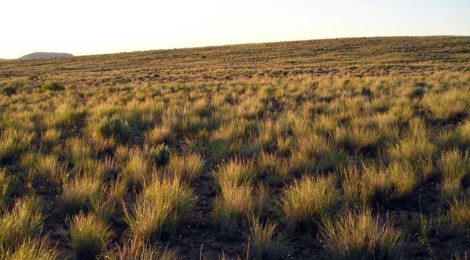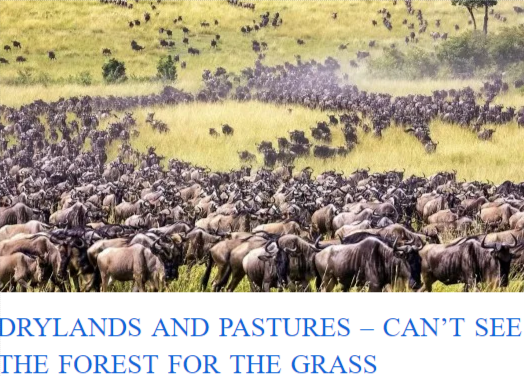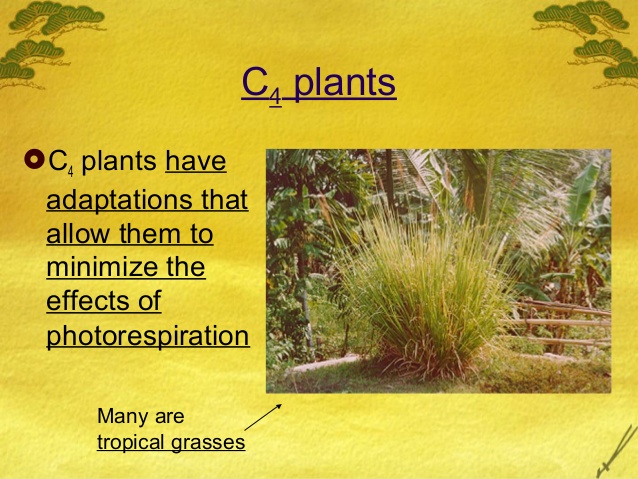
Grasslands Insatiable Appetite For CO2
Most Grass On Planet Earth Grows In Dryland Ecosystems
These bunch grass-lands that cover more of the Earth than forests are predicted to expand their range as the CO2 rises
More grass growing means less dust blowing
Grasslands, especially the dryland bunch grasses are growing faster as carbon dioxide levels rise, according to data from a long-term ecological field experiment in Minnesota. The research findings, published on 19 April in Science, run counter to some long-established ideas about how plants will respond to the greenhouse gas. This finding suggests that grasslands could provide a buffer against climate change, but there is a darker ecological side to better growing grass on land. More grass growing means less dust blowing and for the vast majority of living ecosystems on this blue planet that’s terrible news.
This paper adds to a long list of papers reporting on the benefit of high and rising CO2 for those plants whose life-cycles are attenuated by the droughty habitat they live in. There is a longstanding question about how Earth’s two major groups of plants will respond to the growing level of CO2 in the atmosphere. The C-3 group species (most land plants) when they capture energy to use in photosynthesis use sunlight to synthesize sugars from the immediately available CO2 and water. In theory, giving these plants extra CO2 might rev up their energy production. Such C3 plants include all of the trees, most human food plants, generally speaking, the more succulent plants.
The other group of plants — so-called C4 species — are the dryland plants that have evolved to conserve water and thus be drought tolerant. They use a two-step process regarding CO2, the key first step is to aggregate their internal CO2 levels before photosynthesis takes place, making energy production more efficient. For decades, some scientists have argued that C4 plants would not benefit from additional CO2 in the atmosphere because they are already using turbo-charged CO2. But this recent Science paper adds itself to a long list of papers that note the opposite is true.
“The main message is don’t count out the C4 grasslands,” says Dana Blumenthal, an ecologist with the US Department of Agriculture in Fort Collins, Colorado. B
This is because C4 plants evolved to live in hot and arid conditions, scientists have long projected that the species will expand their range as the climate warms. Now, it turns out that they also pull more CO2 out of the atmosphere. As such these plants are regulated not by the amount of CO2 they consume, but rather by the amount of water they lose when respiring/breathing to obtain their CO2. With more CO2 in the air, the plants regulate their breathing so as to reduce evapo-transpiration, water-loss. By reducing the loss of their vital water they are able to greatly extend their growing season.
Grasslands questions
The latest findings come from the long-running Biodiversity, CO2 and Nitrogen (BioCON) experiment. Beginning in 1997, researchers planted C3 and C4 plants on 88 open-air plots about 50 kilometres north of Minneapolis, Minnesota. The team then pumped in enough CO2 to some of those plots to raise the average atmospheric concentration of the gas to around 550 parts per million — about double the historic levels and about double the present fossil fool age enhancement of CO2. For the first 12 years, the growth rate of the C4 plants exposed to extra CO2 did not increase. But over the next eight years, that group outperformed C4 plants that weren’t grown in the high-CO2 environment.
The scientists note that as CO2 levels rose, the plants grew bushier and remained greener for a longer time each year and curiously the amount of nitrogen available to the plants also increased. Nitrogen is an essential nutrient that is crucial to photosynthesis. One obvious speculation is that as the ‘ground cover’ increased it supported changes in the composition of soil microbes and their nitrogen fixation potency drove the increase in nitrogen.
“It’s a huge surprise,” says Peter Reich, an ecologist at the University of Minnesota in Saint Paul who heads the experiment. “I don’t think any scientist in the world would have predicted it.”

6.1 billion hectares of Earth is ‘Drylands’, 5.1 billion hectares is treeless ‘tundra’, 2 billion hectares of wet grasslands, a mere 4 billion hectares are forest – Click to read more
Scientists estimate that plants absorb roughly one-quarter of humanity’s carbon emissions each year, and the Minnesota experiment is one of several that have sought to determine whether that trend will continue as atmospheric CO2 levels rise. Much of the research has focused on C3-dominated forests, which absorb large amounts of CO2 from the atmosphere, but now the vast dryland grasses are again shown to have a major role.
Scientists had thought that the forests would be likely to grow faster when exposed to higher CO2 levels in the atmosphere. But that’s not what experiments have shown. When C3 plants are exposed to higher Co2 levels, their rate of growth increases for a period — but eventually the plants are hobbled by the limited availability of nutrients such as nitrogen and phosphorus.
Reich and his colleagues saw a similar effect in the C3 plants that they exposed to high CO2 levels. But their initial boost in productivity disappeared entirely around the same time that the fertilized C4 plants began to grow more quickly.
“The lesson is that photosynthesis doesn’t equal growth,” says Richard Norby, an ecologist at the US Department of Energy’s Oak Ridge National Laboratory in Tennessee. He says that if scientists want to understand how an ecosystem’s plants will respond to increased CO2, they need to look at how nutrient cycles change over time.
“You can’t get at that with short experiments.”
Global perspective
In addition to the Minnesota site, two similar CO2 field experiments are operating in forests outside of Birmingham, UK, and Sydney, Australia. Brazil has been working for several years to establish their first such experiment in a native tropical forest, although Norby says that the project has encountered funding troubles. The US Department of Energy has been conducting field work in tropical ecosystems in Puerto Rico, Panama and Brazil, but plans to shut that research down early.
Reich and his colleagues working at the Minnesota site are now focusing on how the microbial community there might be changing below the greatly enhance ground cover of better growing grass. That includes fungi that inhabit plant roots, and microbes that decompose dead plants and release nutrients such as nitrogen. Pinning those details down will help scientists to understand more about why C4 plants seem to thrive as CO2 levels rise, but Reich says that the results of his experiment won’t be enough to pin down what’s happening.
“The reason we can’t say exactly what this means globally is that we really need a dozen of these experiments, not just one,” he says.
End of Part 1
What these researchers have left out is the vital relationship C4 plants have with the 72% of this blue planet that sustain the ocean pastures.
Green or Blue-Green — Understanding Our Planets Plant Life
Our world sustains plant life in two forms, those green plants that live in soil and depend on vital rain/water that arrives in the wind to survive and thrive, such plants cover the 17% of this Blue planet that is not ice or rock and supports growing vegetation.
The rest, the 72% blue part, of this planet is filled with green plants, phytoplankton, that lives in water and depends utterly on receiving vital mineral micronutrients that blow to it from the land in the form of dust in the wind. This is where the crisis of CO2 becomes most dire, as more grass growing means less dust blowing!
From Part 1 of this post it is clear that our CO2 is making the dusty regions of the world, the drylands, grow more grass.
The Dust Drought
The reduction of dust in the wind due to our high and rising CO2 has already resulted in a massive many decades-long ‘drought’ of dustfall in the world’s vital ocean pastures. As a result ocean pasture productivity has collapsed around the world. While it is fashionably politically correct to blame the disappearance of fish in the oceans on convenient ‘bad over-fishing fishermen’ in reality it is each and every one of us and our fossil CO2 emissions that is killing ocean life. This is not to say we are proposing to let the dastardly over-fishing bogeymen off the hook as they are indeed compounding the crisis by over-fishing the last of dwindling fish populations dying out on rapidly disappearing ocean pastures. The good news is that we can immediately restore our oceans and their ocean pastures.
Everyone knows the basics of pasture ecology, as the grass disappears from pastures, be they on land or at sea, those pastures lose the ability to sustain animal life.
It is easy to see the collapse of a pasture on land when grass growing disappears and the dusty dirt is all that remains with little or no grass to sustain our herds of domestic animals or wildlife.
Seeing ocean pasture collapse is more difficult as we humans only ever see the blue surface of our oceans, in fact, most humans think the clearer and bluer the ocean is the more beautiful it is. Just look at any advertisement for a beautiful ocean holiday location.
Increasingly common reports of dying marine life reveal the crisis
The Solution
We must replenish the dust our modern age has and is denying the oceans and their vital pastures. By giving back tiny amounts of mineral-rich dust to the oceans we can bring back all of ocean life, the plankton, the krill, the squid, the seabirds, the seals and sea lions, the great whales, and the fish!
The cost of restoring our ocean pastures to historic levels of health and abundance will be absolutely trivial when compared to the expected trillions to be spent annually to full-fill the terms of the recent Paris Climate Change Accord. Proven methodology and technology can, and will, safely and sustainably restore ocean pastures in all of the world’s seven seas for mere millions of dollars, NOT trillions!
















